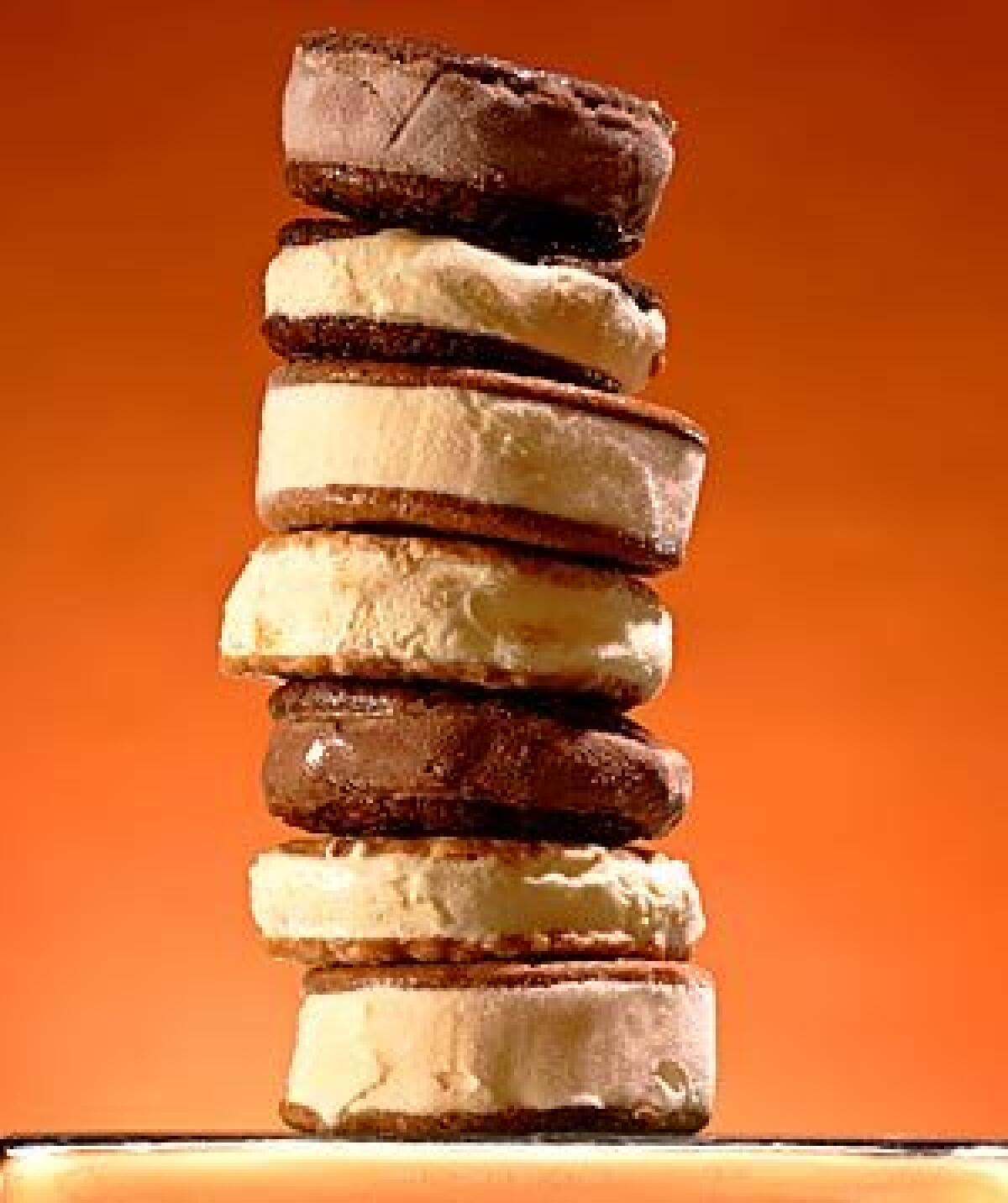The sweet dream team

- Share via
Slap a generous scoop of ice cream between two cookies, tidy up the edges and pop the whole thing in the freezer until it firms up. How difficult can it really be to make a great ice cream sandwich?
The ice cream is easy. You can really let your imagination go, as far as flavors are concerned, though you’ll be better off choosing premium brands -- they tend to freeze more solidly than less expensive types, which often contain stabilizers.
It’s when you start rummaging through your cookie recipes that things can get tricky. Should they be thick or thin, soft or crispy, rolled or more free-form drop in style?
Once you understand the basics, spotting a sandwich-worthy cookie recipe that you can tweak to your taste is almost as simple as, well, making the sandwich itself.
First of all, the ideal cookies for an ice cream sandwich should be noticeably less sweet than those you want to nibble straight from the oven, because you’re going to be adding a lot of ice cream.
The cookies should also be crispy enough to contrast with the silkiness of ice cream (a super-soft cookie and you’ve got ice cream all over your hands). A little chewiness in the center is also great for contrast as you munch your way through the cookie.
And think about the thickness of the cookie; you’re making a sandwich, not a hoagie.
Those are the broad outlines. When you get to specifics, there are a few more things to consider.
The kind of sugar you use in the cookie also makes a difference. You want a recipe that calls for at least part brown sugar, molasses, honey or maple syrup. A couple tablespoons of these will add a rich caramelized flavor to your cookies.
Just a couple of tablespoons of brown sugar added to a standard chocolate sugar cookie transforms it into a perfect sandwich layer. The brown sugar adds extra moisture and makes the cookie chewier, which is a good thing.
And dough that’s been rolled into balls, rather than dropped directly onto the baking sheet, bakes into more uniformly shaped cookies -- especially handy when you’re matching up perfect sandwiching partners.
You can play even more variations on that simple chocolate cookie if you want. Fold in a handful of chopped nuts, minced dried fruit or use a quarter-teaspoon of almond extract rather than vanilla. Carmela’s, an ice cream stand at several Southern California farmers markets, sprinkles sea salt on its chocolate sandwich cookies prior to baking.
You can also change the texture of the dough by adding oatmeal or coconut. It’ll make cookies more crumbly tender than chewy, but just as moist.
With the addition of coconut, a butter cookie morphs into an almost macaroon-like disc that manages to taste light even when piled with gobs of vanilla or coconut ice cream. Grinding the coconut in the food processor will give the cookies a more uniform texture. A teaspoon of lemon or orange zest is also a tasty addition to the dough, particularly with summery citrus ice creams or tangy sorbets.
With this and other very moist doughs, you need to chill the dough well so the cookies keep a uniform shape while baking. Flattening the sugar-rolled balls with the bottom of a drinking glass dipped in sugar also helps ensure that the tops will fit the bottoms and bake into a thinner sandwiching cookie.
Spice cookie
For the ultimate ice cream sandwich, use a variation on a molasses spice cookie that Suzanne Goin uses at Lucques restaurant in West Hollywood. It’s loaded with cloves, ginger and cinnamon and rolled thin so it’s not heavy but still keeps a fantastic chewy center from the molasses.
It is a stiff dough, which helps the cookies retain a perfectly round shape, so you’ll need to chill the dough and roll it between parchment or plastic wrap to make it easier to work with. This flour-free rolling technique also keeps the cookies moist in the center and helps you transfer the delicate rounds to the baking sheet. You can peel them right off the parchment or plastic.
After baking, cool thin cookies such as these directly on the baking sheet rather than on a rack. It will steam them enough to slightly soften them. Now the crispy edges won’t crumble when you slather them with ice cream (the filled cookies will soften up even more after a few hours in the freezer).
And about the ice cream. That’s the easy part. It’s worth it to look for premium brands. They tend to freeze more solidly than less expensive types, which often contain stabilizers.
Don’t be afraid to play with flavors. Goin uses the gingerbread cookies to make sandwiches with pumpkin or maple ice creams during the fall, or lighter stone fruit sorbets or vanilla ice creams in the summer.
Tropical flair
The coconut cookies are a natural for tropical flavors such as pineapple, mango or even coconut ice cream. I also like everyday vanilla ice cream with the sides of the sandwich rolled in flaked coconut (do this just after you fill the cookies so the ice cream is still soft enough for the flakes to adhere).
Make enough chocolate sea salt sandwich cookies so that you can fill them with a mix of pecan praline, chocolate almond or one of those crazy everything-but-the-kitchen-sink ice creams, and you’ve got a virtual ice cream truck permanently parked in your kitchen, without the endlessly looped “Pop Goes the Weasel” soundtrack.
More to Read
Eat your way across L.A.
Get our weekly Tasting Notes newsletter for reviews, news and more.
You may occasionally receive promotional content from the Los Angeles Times.









